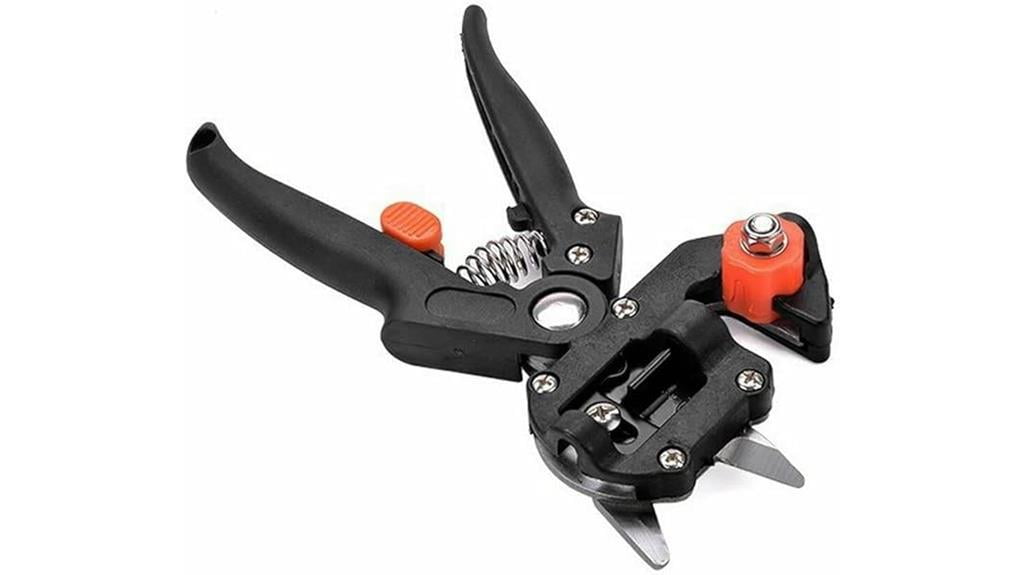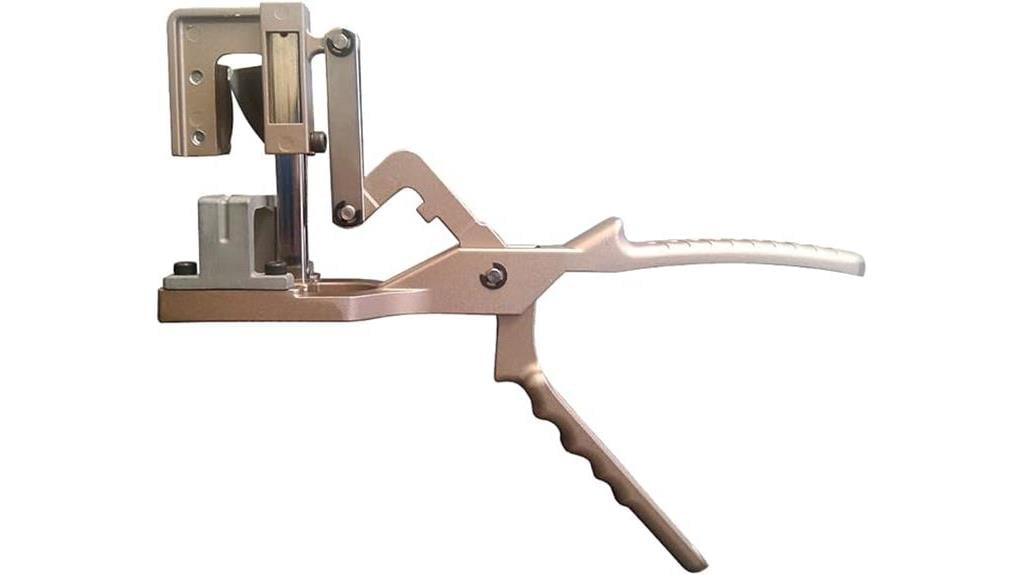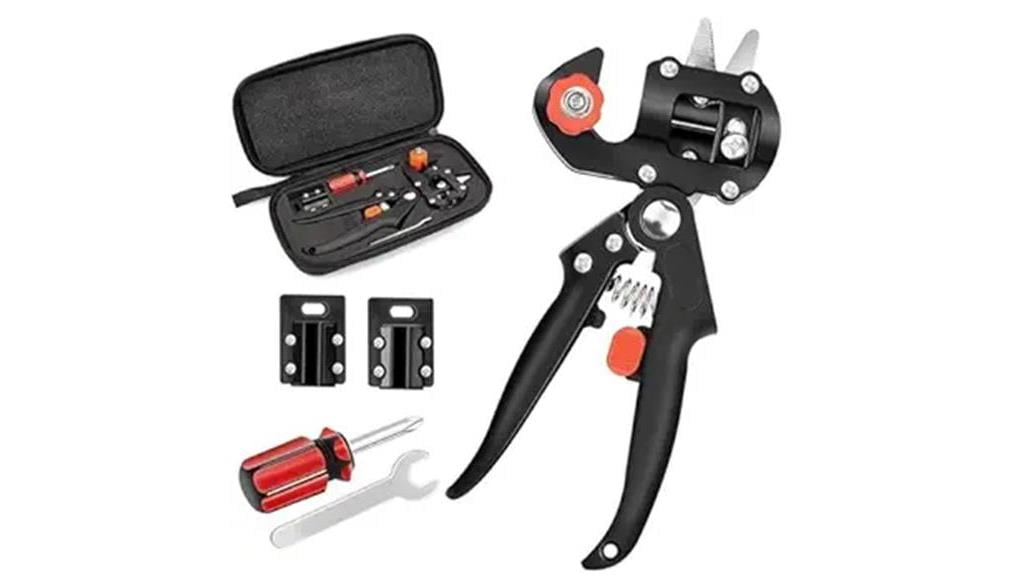When it comes to successful plant propagation, having the right grafting tools can make all the difference. You might be wondering which tools are essential for achieving the best results in 2024. From specialized V-cut options to versatile scissor sets, the market offers a range of choices tailored to your grafting needs. But before you decide on the best ones for your garden, consider what features truly enhance your success. Let's explore the top five tools and how they can elevate your grafting game this year.
FUNTECK V-Cut Grafting Tool for Large Branches

If you're looking to tackle larger branches with precision, the FUNTECK V-Cut Grafting Tool is an excellent choice for both novice and experienced gardeners. I've found its full metal body and SK5 high carbon steel blade to be incredibly sturdy and effective. The tool's anvil blade creates a clean, professional-quality graft with a 1-inch V cleft cut, which is perfect for branches ranging from 1/2 to 4/5 inch in diameter. With an ergonomic 6-inch handle, it minimizes fatigue during longer sessions. Users report impressive success rates, often around 90%, with proper technique. However, I recommend practicing to hone your skills. Overall, it's a reliable tool that saves time by preparing both stock and scion in one swift cut.
Best For: Gardeners looking for a reliable and efficient tool to create professional-quality grafts on larger branches.
Pros:
- Sturdy construction with a full metal body and sharp SK5 high carbon steel blade.
- Ergonomic handle design reduces fatigue during extended use.
- High success rate of grafting, with users reporting up to 90% success with proper technique.
Cons:
- May require practice and skill to achieve optimal grafting results.
- Users have reported challenges with grafting success, indicating a learning curve.
- Limited to branches with a diameter of 1/2 to 4/5 inch, which may not suit all grafting needs.
Grafting Tool Scissor Set for Plant Grafting

For gardeners looking to enhance their grafting success, the Grafting Tool Scissor Set is an excellent choice. I've found its SK5 sharp blade creates a smooth 1-inch V-cut on both stock and scion, which really boosts the survival rate of my grafts. This set is perfect for thicker branches, accommodating sizes from 8 to 20mm. The ergonomic 6-inch non-slip handle reduces fatigue considerably, saving about 40% in labor costs compared to traditional tools. Made from high-quality aluminum alloy and stainless steel, it's durable and sturdy. Whether I'm working with fruit trees, flowers, or various branches, this versatile tool has become a staple in my gardening toolkit. Plus, it comes with two grafting tapes, making it even more convenient!
Best For: Gardeners looking to improve their grafting success with a reliable and ergonomic tool for thicker branches.
Pros:
- High survival rate due to the sharp SK5 blade, ensuring clean cuts.
- Ergonomic design reduces fatigue, making it easier to use for extended periods.
- Includes grafting tapes, adding convenience for immediate use.
Cons:
- Customer ratings are relatively low at 3.3 out of 5 stars, indicating mixed feedback.
- Best Sellers Rank suggests it may not be a top choice among gardening scissors.
- Limited to grafting branches between 8 to 20mm, which may not suit all gardening needs.
2 in 1 Grafting Tool Pruner Kit for Gardening

The 2 in 1 Grafting Tool Pruner Kit stands out as an ideal choice for both novice and experienced gardeners looking to enhance their plant propagation skills. This versatile tool features a grafting shear with a U-shaped blade and comes with two additional replaceable blades (V-shape and Ω-shape), making it perfect for various cutting needs. With a length of 21.5 cm and a weight of just 300 g, it's easy to handle. The high-quality stainless steel and anti-skid ABS plastic guarantee durability and comfort during use. It effectively cuts branches from 5 mm to 12 mm in diameter, ideal for fruit trees. I recommend lubricating the blade after each use to maximize its lifespan and efficiency.
Best For: The 2 in 1 Grafting Tool Pruner Kit is best for gardeners of all skill levels looking to efficiently propagate plants and maintain fruit trees.
Pros:
- High-quality stainless steel blades offer sharpness and durability.
- Lightweight and ergonomic design makes it easy to handle during extended use.
- Versatile with three replaceable blade options for different cutting needs.
Cons:
- Mixed customer reviews regarding blade performance and effectiveness.
- Requires regular lubrication to maintain optimal cutting efficiency.
- Some users may find the cutting width limiting for larger branches.
Zenport ZJ68 V-Cut Top Tool for Grafting Fruit Trees and Vines, Gray

Grafting enthusiasts looking for a reliable tool will find the Zenport ZJ68 V-Cut Top Tool particularly appealing. This tool excels at creating long V cleft cuts, a method favored in Europe, making it compatible with various fruit trees and vines like apples, plums, and peaches. I appreciate how its clean cuts guarantee a perfect fit, which considerably boosts graft success rates—often reported at 90% or higher. At just 1 pound, it's lightweight and designed for ambidextrous use. However, I've noticed mixed reviews regarding its performance on tougher woods, and some users suggest sharpening the blades for best results. Overall, it's a solid choice for those preferring a tool over traditional grafting knives.
Best For: Grafting enthusiasts seeking a reliable and efficient tool for creating V cleft cuts on various fruit trees and vines.
Pros:
- High success rates of 90% or more for grafting, saving labor costs.
- Lightweight design (1 pound) with ambidextrous usability for comfortable handling.
- Effective for a variety of soft fruit trees and vines, ensuring clean cuts for better grafting outcomes.
Cons:
- Mixed performance on tougher woods, potentially leading to uneven cuts.
- Some users report issues with crushed bark on the anvil side of the cut.
- Lack of a safety lock may pose a risk of accidental cuts during use.
SUCA Grafting Tool Kit for Garden Pruning

If you're a beginner looking to explore the world of plant propagation, the SUCA Grafting Tool Kit is an excellent choice. This kit includes garden pruners, replacement blades, and grafting tape, making it versatile for budding and grafting various plants like citrus and apple trees. I appreciate that it offers two rolls of elastic, waterproof tape in different widths, ensuring a solid moisture barrier. Users often report a high success rate, with one achieving over 90% with citrus. While not the highest professional quality, it performs well for the price. Plus, the compact design and carrying bag make storage easy. For anyone interested in grafting, this kit provides great value and functionality.
Best For: Beginners and hobbyists interested in exploring plant propagation and grafting techniques.
Pros:
- Easy to use for beginners with effective results in plant propagation.
- Includes multiple accessories such as replacement blades and grafting tape for enhanced versatility.
- Compact design with a carrying bag for convenient storage and transport.
Cons:
- Not the highest professional quality, which may limit use for advanced grafting needs.
- Grafting tape may be prone to drying out, affecting its adhesive properties.
- Success rates can vary based on technique, not just tool quality.
Factors to Consider When Choosing Grafting Tools
When you're choosing grafting tools, consider the type that best suits your needs. Pay attention to blade material quality, as this can affect durability and performance. Also, think about ergonomic design, cut depth capability, and whether the tool matches the branch sizes you'll be working with.
Tool Type Selection
Selecting the right grafting tool is important for successful plant propagation. You need to match the tool type to the size of branches you're working with—look for tools designed for diameters from 1/2 inch to 4/5 inch, or 8 mm to 20 mm for thicker branches. Consider the style of the grafting tool, whether it's V-cut, U-cut, or Ω-cut, as each provides unique cut shapes that can greatly influence your success rate.
Ergonomics play a significant role too. Opt for tools with comfortable handle designs and lightweight materials to minimize fatigue during long grafting sessions. Some tools can save you up to 40% in labor costs, making them a smart investment.
Additionally, make sure the tool is compatible with both the scion and rootstock. This compatibility is essential so that the cuts align well, promoting ideal cambial contact for better graft success. Ultimately, the right tool not only enhances your grafting efficiency but also improves your overall propagation outcomes. Keep these factors in mind to select the best grafting tool for your needs.
Blade Material Quality
The quality of blade material plays an important role in the effectiveness of your grafting tools, directly affecting both durability and cutting efficiency. When choosing grafting tools, consider blades made from high carbon steel or stainless steel. High carbon steel, like SK5, is known for maintaining a sharp edge longer, which helps you make smooth cuts essential for successful grafting. Stainless steel is also an excellent choice due to its resistance to rust and wear.
Alloy steel blades can provide solid performance too, offering clean cuts that align cambial areas, necessary for improving your grafting success rates. Additionally, pay attention to the thickness and design of the blade, as these factors influence its cutting capacity. For example, blades designed for 1-inch deep cuts are versatile enough for various scion and rootstock sizes.
Regular maintenance is key to preserving blade quality. Sharpening and lubricating your blades will guarantee peak performance during grafting tasks. By prioritizing the right blade material and maintaining it properly, you'll enhance your grafting experience and increase your chances of successful plant propagation.
Ergonomic Design Features
Choosing grafting tools with ergonomic design features can greatly enhance your overall experience. You'll want to look for handles that are around 6 inches long, as they're specifically designed to reduce hand fatigue during extended use. A comfortable grip improves leverage, making your work easier. Additionally, non-slip handle designs boost control and stability, minimizing the risk of accidents and ensuring better cutting precision.
Consider the tool's weight, ideally between 1 to 1.6 lbs. A well-balanced tool allows for easier maneuverability and reduces strain on your arms and wrists, making those longer grafting sessions more manageable. If you're left-handed, or if you occasionally use your right hand, opt for tools with ambidextrous designs. This versatility will save you frustration and improve your overall efficiency.
Lastly, features like anti-skid materials and chrome-plated surfaces can elevate your comfort level. These elements prevent slippage and rust formation, enhancing the tool's longevity. Ultimately, selecting grafting tools that prioritize ergonomic design will not only make your grafting tasks easier but also more enjoyable.
Cut Depth Capability
When you're gearing up for grafting, cut depth capability plays an essential role in ensuring success. The depth at which your tool can cut directly affects how well the scion and rootstock align, promoting ideal cambial contact. Most grafting tools offer a cut depth of around 1 inch, which is usually sufficient for small to medium branches. However, if you're working with larger branches, look for tools that can manage depths accommodating diameters from 1/2 inch to 4/5 inch or more.
It's vital to choose a tool that creates precise and clean cuts at your desired depth. Clean cuts facilitate quicker healing, which can greatly enhance your graft's survival rate. If the cut is jagged or uneven, it can hinder the grafting process, leading to failures.
Compatibility With Branch Size
Finding the right grafting tool that matches the branch size you're working with is crucial for a successful graft. Typically, you'll encounter branches ranging from 1/2 inch to 4/5 inch in diameter, and many grafting tools are designed specifically for certain branch sizes. For instance, some tools are best for branches measuring 8 mm to 20 mm, approximately 0.31 inch to 0.79 inch.
When choosing a tool, consider the cutting depth, as a tool that executes a 1-inch long cut will generally yield better results than one with a shallower cut. This guarantees that you create an ideal surface for grafting. Also, if you're tackling thicker branches, look for ergonomic features like 6-inch handles, which can considerably reduce fatigue during extended use.
Lastly, be mindful of the blade type. Tools designed for softer woods may struggle with tough, knotty branches, so verify you select a tool that matches the wood type you're grafting. By keeping these factors in mind, you'll improve your chances of a successful grafting process and healthier plant propagation.
Maintenance and Durability
After selecting the right grafting tool based on branch compatibility, the next step involves ensuring that your tools remain in top condition for effective use. The material of your blades plays a significant role in durability. Opt for high-quality stainless steel or SK5 high carbon steel, as these materials resist wear and damage better. Regular maintenance is key; sharpen the blades after each use and lubricate moving parts to extend their lifespan and maintain cutting efficiency.
Consider investing in tools with replaceable blades. This feature allows you to maintain performance without replacing the entire tool, making it a cost-effective choice. Additionally, ergonomic handles can enhance your comfort during prolonged use, reducing stress on the tool and improving durability.
Price and Value Comparison
Choosing the right grafting tools involves more than just picking the most expensive option; it's about finding the best value for your gardening needs. Start by examining the cost-to-feature ratio; some tools provide similar functionalities at lower prices, which can maximize your budget.
Look for tools that include additional accessories like grafting tape or replacement blades. These extras can enhance your experience without greatly raising the initial price. User feedback is essential, too. Investigate the long-term durability and effectiveness of each tool, as a higher upfront cost might be justified if it leads to better performance and longevity.
Don't forget to evaluate reported success rates. Tools that consistently yield high grafting success may warrant a premium investment. Finally, consider the warranty and return policies associated with the tools. Favorable terms add considerable value and peace of mind to your purchase decision. By balancing these factors, you can confidently choose grafting tools that not only fit your budget but also enhance your plant propagation success.
Frequently Asked Questions
How Do I Maintain My Grafting Tools for Longevity?
To maintain your grafting tools for longevity, clean them after each use to remove sap and debris. Use a soft cloth and a mild detergent, then dry them thoroughly to prevent rust. Sharpen the blades regularly to guarantee clean cuts, and apply a light coat of oil to protect against corrosion. Store your tools in a dry place, away from moisture, to keep them in top condition for your next grafting project.
Can I Use Grafting Tools for Other Gardening Tasks?
You might think grafting tools are only for grafting, but they can actually be versatile. You can use those sharp blades for pruning small branches or cutting plant material for propagation. The precision helps in making clean cuts, which is essential for plant health. However, just be cautious—using them for other tasks might dull the blades faster. So, while they can help in various gardening tasks, proper maintenance is key to their longevity.
What Safety Precautions Should I Take While Grafting?
When you're grafting, it's essential to prioritize safety. Always wear gloves to protect your hands from sharp tools and potential infections. Use a sturdy cutting surface to avoid slips, and make certain your tools are clean and sharp to minimize injury risk. Keep your workspace organized to prevent accidents, and consider wearing safety goggles if you're working with particularly tough materials. Taking these precautions will help you graft effectively and safely.
How Do I Choose the Right Grafting Technique?
Choosing the right grafting technique depends on the plants you're working with and your goals. First, consider their compatibility; some varieties work better together. Next, think about the desired outcome, like speed of growth or resistance to disease. You might want to try techniques like splice, whip-and-tongue, or cleft grafting, depending on the thickness of the scion and rootstock. Don't forget to practice and refine your skills for better results!
What Are the Best Plants for Beginners to Graft?
When you're starting out, consider easy-to-graft plants like tomatoes, apples, and roses. They're forgiving, you'll see quick results, and you'll learn a lot. You'll enjoy the process with herbs like basil and mint too; they adapt well and root easily. Focus on these beginner-friendly choices, and you'll build your confidence. Experiment with different varieties, and before long, you'll be grafting like a pro, enjoying the fruits of your labor!
Wrapping Up
When it comes to grafting, choosing the right tools can make all the difference. Just like finding your favorite pair of gardening gloves, it's about comfort and effectiveness. Whether you're tackling large branches with the FUNTECK or perfecting your technique with the SUCA Kit, you'll find that each tool has its charm. So, grab your grafting tool and enjoy the serendipity of watching your plants thrive, just like that unexpected bloom in your garden!
